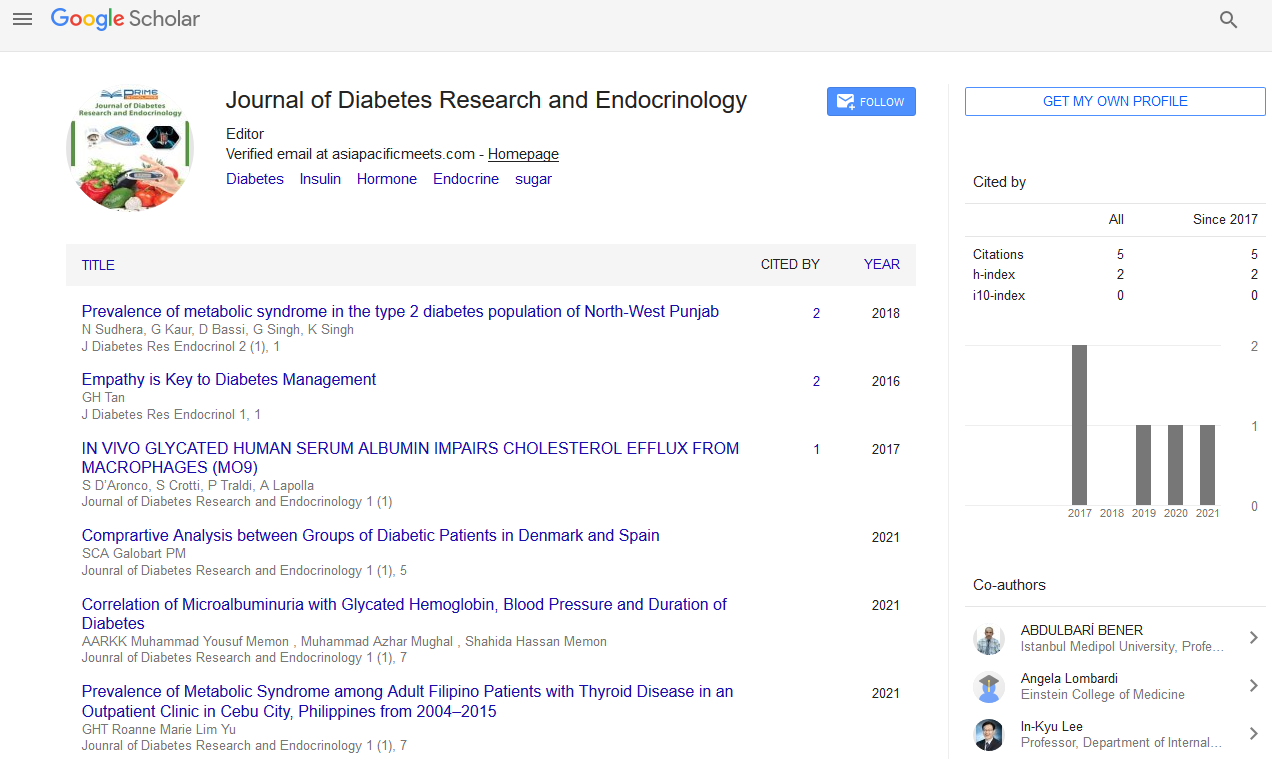Queenie Chan*
Department of Community Health Sciences, College of Applied Medical Sciences, King Saud University, Riyadh, Kingdom of Saudi Arabia
- *Corresponding Author:
- Queenie Chan
Department of Community Health Sciences,
College of Applied Medical Sciences,
King Saud University,
Riyadh,
Kingdom of Saudi Arabia,
E-mail: QueenieChan@yahoo.com
Received Date: July 05, 2021 Accepted Date: July 19, 2021 Published Date: July 26, 2021
Citation: Chan Q (2021) General Diet Composition of Diabetic Patients. J Diabetes Res Endocrinol. Vol.5 No.4:2.
Description
A diabetic eating routine is an eating regimen that is utilized
by individuals with diabetes mellitus or high glucose to limit
indications and hazardous inconveniences of long haul heights in
glucose (i.e.: cardiovascular infection, kidney illness,
corpulence). Among rule suggestions including the American
Diabetes Association (ADA) and Diabetes UK, there is no
agreement that one explicit eating regimen is superior to other
people. This is because of an absence of long haul excellent
examinations on this topic. For overweight and fat individuals
with diabetes, the main part of any eating regimen is that it
brings about loss of muscle to fat ratio. Losing muscle versus fat
has been demonstrated to further develop blood glucose control
and lower insulin levels. The most settled upon proposal is for
the eating regimen to be low in sugar and refined carbs, while
generally high in dietary fiber, particularly solvent fiber. In like
manner, individuals with diabetes might be urged to diminish
their admission of starches that have a high glycemic list (GI),
albeit the ADA and Diabetes UK note that additional proof for
this proposal is required.
Individuals with diabetes can eat any food that they need,
ideally a sound eating routine for certain starches, however they
should be more perceptive of the carb content of food varieties
and stay away from basic sugars like squeezes and sugarimproved
refreshments. For individuals reliant upon insulin
infusions (both sort 1 and some sort 2 diabetics), it is useful to
eat a predictable measure of starch to make glucose the
executives simpler . in da t e ther e is no c onsensus tha t an
diet consisting of any particular macronutrient composition
(i.e.the ratio of fat, protein, and carbohydrate in the diet) is
more beneficial for diabetics. However, research on diabetic
diets is limited due to the nature of nutritional research. Studies
in this space tend to be observational as opposed to
experimental, relatively short in duration, and have relatively
poor compliance due to the difficulty of controlling the diets of
study participants at all hours of the day for extended periods of
time. Thus, more large-scale multi-center trials in the future are
required to further define recommendations. Carbs incorporate
sugars, starches, and fiber. These food varieties greatestly affect
glucose levels as whenever they are burned-through they are separated into sugars that retained in the small digestive tract.
The American Diabetes Association (ADA) doesn't suggest a
particular measure of starch utilization for diabetic weight
control plans. Despite the fact that it isn't prescribed to utilize
fructose as an additional sugar since it might unfavorably
influence plasma lipids. There is no base required measure of
day by day dietary carbs as the body can make glucose through
different metabolic cycles including gluconeogenesis and
glycogenolysis. The equivalent isn't valid for the protein and fat
as both contain constituent segments that are fundamental and
can't be orchestrated through human digestion. The ADA
likewise addresses the glycemic file and glycemic heap of food
varieties as they relate to diabetics, yet they decay to make
explicit proposals because of the indistinct clinical utility. In any
case, meta-investigations including the latest Cochrane
Systematic Review have tracked down that a low glycemic file
diet brings about better blood glucose control as estimated by
glycated hemoglobin A1c (HbA1c) just as less hypoglycemic
scenes. Advantages might be gotten by utilization of dietary
fiber. There is some proof that devouring dietary fiber might
assist with controlling glucose levels; notwithstanding, the ADA
doesn't suggest any various objectives for fiber consumption for
diabetics contrasted with non-diabetics. The ADA doesn't make
a particular suggestion about the aggregate sum of fat that
ought to be devoured by diabetics on an everyday basis. Yet at
Mastering Diabetes, the proposal is close to 30grams each day.
They do take note of that reviews have shown that high fat
eating regimens that have supplanted starches with fat have
shown improved glycemic control and further developed blood
lipid profiles (expanded HDL focus and diminished fatty
substances) contrasted with low fat eating regimens. The ADA
suggests staying away from all food varieties that have
counterfeit wellsprings of trans fats however note that the
modest quantity of trans fats that normally happen in meat and
dairy are not a worry. Verifiably, there has been worry about the
degree of protein utilization in people who have diabetes
actuated kidney illness; in any case, there is no proof that low
protein eats less further develop kidney work. There is no proof
that people with diabetes initiated kidney infection need to
confine protein admission not exactly a normal individual's
admission

